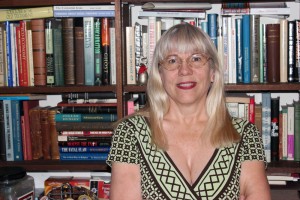Meet the AHA Staff: Jan Melchior

Please welcome the newest addition to the American Humanist Association staff, Jan Melchior, graphic designer!
TheHumanist.com: What is your educational and work background?
I am a graduate of the School of Visual Arts in New York. Mine was one of the last classes to learn the graphic design trade using a drafting table, a t-square, a triangle, and an X-Acto knife. I am so glad we use computers now, although there is something to be said about learning traditional skills. I began my career in publishing. My claim to fame is that I designed the Martha Stewart Wedding Planner during the time I planned my own wedding. From publishing, I moved into pharmaceutical publishing and marketing and from there into development work with not-for-profits. I have spent numerous years of my career working as a consultant or an independent contractor. I’m thrilled to be full-time in an office both because the rhythm suits me and for the pleasure of working with other skilled professionals.
TheHumanist.com: What interested you most about working for the American Humanist Association?
I happened upon the graphic designer position at the American Humanist Association as I was beginning to look for positions in the DC area for both professional and family reasons. After exploring the website and reading the FAQs, I was amazed at how much the organization echoed my own philosophical thinking. It was as if I had written the site myself (perhaps not quite so articulately). The position looking to be filled was an excellent match to my skills, and it seemed a wonderful fit.
TheHumanist.com: Did you grow up in a particular religious tradition? What was the experience like for you?
I was raised a Quaker in a family of many generations of Quakers. Quakerism is a very personal, individual way to approach “worship,” one without many supernatural beliefs and little or no ritual practices. My father was a self-proclaimed agnostic, and my mother didn’t really speak about her beliefs. My religious experience was mostly silent meeting for worship, a gathering of Quakers who sit together in a meeting house in meditative silence and occasionally get up to say something when the “spirit” moves them. For me as a child, it was pretty much torture sitting still for that long.
As I grew older and was introduced to the religious practices of friends, I was very surprised—shocked in fact by all these wonderful smart, regular people, including grown-ups, with these supernatural beliefs and strict, odd magical things like holy water, priests in funny outfits swinging incense around the room, crackers made of a human body, and so on. It totally freaked me out. Now I understand a little better about traditions and how people are raised—but it still freaks me out.
TheHumanist.com: Have you read any good books lately? What’s your favorite book?
I read all the time. I love a good mystery. I love good fiction. Two recent great reads: Carthage: A Novel by Joyce Carol Oates and The Winter of Frankie Machine by Don Winslow.
TheHumanist.com: If you could have dinner with any three people (living or dead), who would they be and why?
- I’d love to sit in a safe spot with Genghis Khan and get the real story of his experiences and beliefs.
- William Shakespeare. I want to know about his process and what he did and did not write.
- Martin Scorsese. His films served as the background to my twenties, and I would love to discuss those times with him and his point of view looking back from now.
